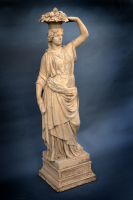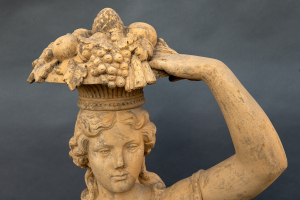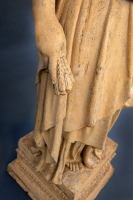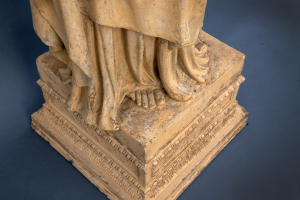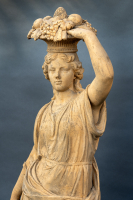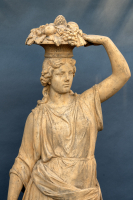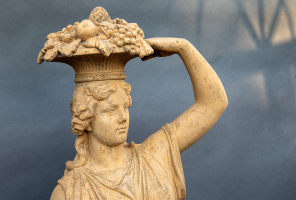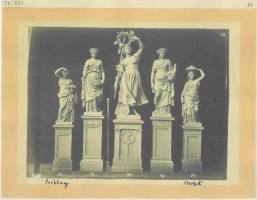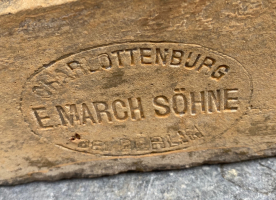- Home
- A mid 19th century terracotta statue of Autumn
A mid 19th century terracotta statue of Autumn
A mid 19th century terracotta statue, representation for autumn, executed by the German firm Ernst March & Söhne, Berlin-Charlottenburg; circa 1850
Sculpted all around, neoclassical statue: striding on a square plinth, in a classic floor-length robe, she balances with her left hand a basket, abundantly filled with fruit, on her head, holding a bundle of ears of corn in her right hand; on a matching low plinth; the sculpture stamped Charlottenburg E MARCH SÖHNE bei Berlin, see catalog Ernst March Thonwaaren Fabrik, Charlottenburg bei Berlin, Berlin, 1870, page 10 under no. 86 Herbst (see photo).
The initial pottery and later earthenware factory founded in 1836 by Ernst March (1798-1847) was founded in Charlottenburg, was one of the largest and most renowned factories specialising in terracotta. In addition to garden and park sculptures, the company produced a variety of architectural ceramics which survive to this day on many important public buildings in Potsdam (e.g. baldachin fountain and Muses group Sanssouci Palace) and such as in Berlin: the Red Town Hall (Rotes Rathaus), the Martin-Gropius-Bau (Berlin Museum of Decorative Arts), Görlitzer Bahnhof, the Neues Museum and the Friedrichswerdersche Kirche. Around 1896, the Ernst March & Söhne factory employed 150 workers and consumed 1,500 tonnes of clay annually.
Dimensions: the statue 141 cm high;
the plinth 19 cm high, 43 x 43 cm square
total height 160 cm
Condition: good condition, ‘nice’ flaw on the nose
Reference: KOE012023
Further reading:
ERNST MARCH & SÖHNE
Ernst March Söhne, or Ernst March & Sons is a private firm, whose works and offices are at Charlottenberg, once a suburb, but now a portion of Berlin. The works were established in 1836 by the grandfather of Albert March, who took the business over on the 1st of January 1899 from his father and uncles. For a long time the only product of the works was high art terra cotta, and so beautiful was it that the reputation of March & Sons stood deservedly higher than that of any other maker of terra cotta in the world.
The March & Sons’ works are the most artistic in themselves that I have ever seen anywhere. They would afford a very useful object lesson to several terra cotta manufacturers I have in mind, whose works are mere factories of the homeliest description and sometimes show that the pursuit of the nimble dollar does not even leave time for sweeping the floor. It is said that “Who drives fat oxen should himself be fat”, and the man who makes things of beauty, which he invites other men (architectes and possible purchasers) to come and see, should have his surroundings somewhat in agreement with the high art he professes to produce. The contrary of this is just as incongruous as it is for the maker of bricks and tiles to live in a wooden shanty with a single rooi.
.../...
The terra cotta of all the magnificent buildings that I saw in Berlin appeared to have been made by March, such as the Church of the Holy Cross, the arcade and very many others.
Although the manufacture of high art terra cotta was a profitable industry and there was an ample demand for the ware, from abroad as Well as at home, including South America for religious figures, the increasing demand for refractory ceramic ware, for chemical and other purposes, and the considerably greater profit from this, tempted the firm to take up this work.
While terra cotta is stil made the manufacture of ceramic apparatus for the chemical industries, for electrical work, for galvanic and electro plating establishments, and for laboratories, etc., has been receiving more and more attention each year, since about 10 years ago when it was first undertaken.
‘Brick and Clay Record’ (USA) - Volume II, Issue 4; 1899
Antieke Tuinornamenten
Viooltjesdreef 39031 Baarle-aan-de-Leie
info@antieke-tuinornamenten.be+32 (0) 9 282 20 97+32 (0) 475 53 41 63
Opening hours
Bezoek aan de tuin enkel na afspraak.

